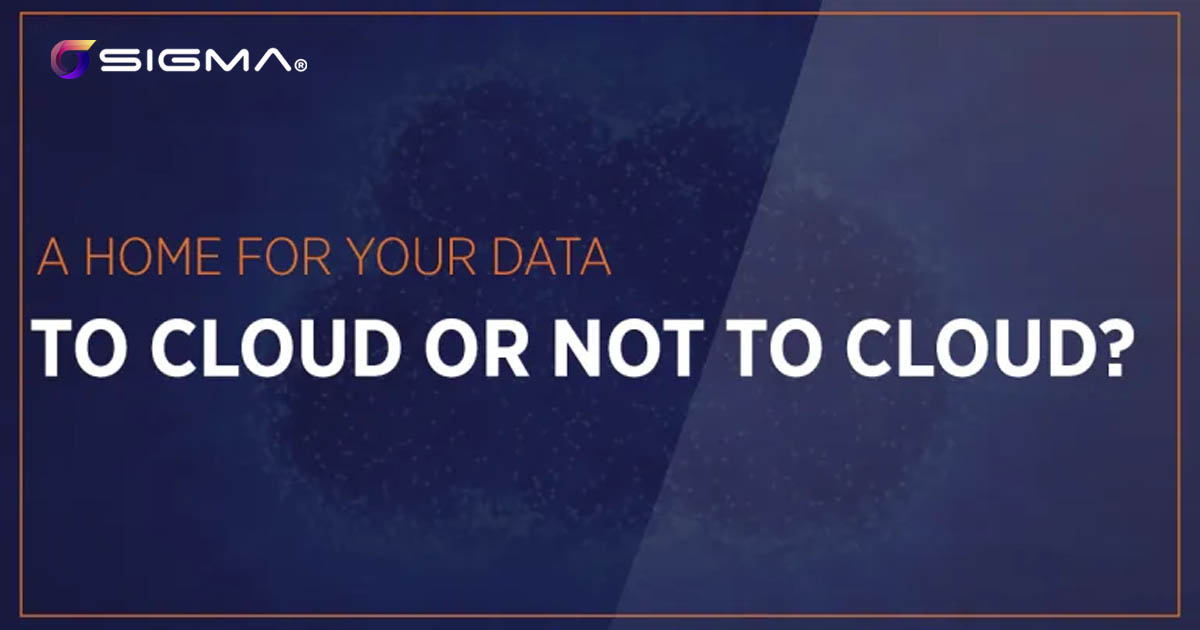
To Cloud or Not to Cloud?
It seems that everybody is rushing to “embrace the cloud” these days. Everywhere you look, businesses are rushing to make the transformation from having their data on-premises to uploading it to remote servers, usually provided by cloud computing giants such as AWS, Oracle, Dell-EMC, or Microsoft.
And while cloud computing is nothing short of a revolution in the world of IT, we should be aware that it’s not exactly a magic bullet that is guaranteed to make all your IT dreams come true. Sometimes keeping your data on-prem is—in fact—the better option, or even repatriating cloud-hosted data back to your premises.
Which option should you choose?
Should you migrate your data to the cloud? Or keep it on-prem?
It’s not an easy question to answer since it requires taking many factors into consideration. No two businesses or organizations are exactly identical, so there is no one-size-fits-all answer. The following points might be useful to consider when trying to find an answer.
Is your sensitive data safe on the cloud?
Many organizations believe that sensitive data does not belong in the cloud because it can be infiltrated by malicious parties. This is a valid argument, but it begs these two questions: What really is sensitive data? And what is the level of security you’re employing in your current practices?
Any data is sensitive to a certain degree (even your XBOX Live account credentials), but what really highlights that sensitivity are the lengths you’re willing to go to in order to protect it or the standards to which you need to comply to operate in that industry.
Having your data on the cloud doesn’t mean that it’s unsafe, but you might require a greater degree of control over security than what your cloud provider is offering, which would make their solution unsuitable for you.

Data in military, paramilitary, and government organizations may only be accessed by a handful of people, and these organizations take critical measures to ensure that their data is secure. Likewise—but to a lesser degree—are institutions in the financial and healthcare sectors that deal in the private and potentially exploitable data of their beneficiaries. They’ll go to great lengths to make sure their data is unobtainable by third parties. Security standards in those industries even dictate the measures that need to be in place to ensure data security, which might not be available through your cloud provider (or at prices you can afford).
Having your data on the cloud doesn’t mean that it’s unsafe, but you might require a greater degree of control over security than what your cloud provider is offering, which would make their solution unsuitable for you.
Is your data vulnerable ONLY through the cloud?
Data on the cloud may be exposed to attack, though cloud providers are aware of the dangers and are constantly on the alert, monitoring their security, beefing it up, and patching any loopholes that are discovered. However, if you’re concerned about security on the cloud, but are using the internet for email—for example—then your data is already exposed to the public network where it is also vulnerable to attack. Bear in mind that your email messages will probably contain details on everything in your business, including your trade secrets, strategies, prices, insider knowledge, etc. The risk you run by having data on the cloud is about the same in this case, so it doesn’t make sense to object to one but use the other.
You might need to take a more holistic approach to security in your entire organization before letting that deter you from migrating.
Does the region you’re operating in have poor internet connectivity?
With the world becoming one global market, you can easily find your business having to conduct its operations from a country or region that suffers from poor internet connectivity. If you rely on the cloud, then failure to connect will hamper your operations and may result in incurring massive costs and loss of business. This is apparent in manufacturing plants that may constantly need info to regulate operations and cannot halt their machinery because it causes a costly waste of materials.
On the flip side though, poor internet connectivity brings with it the obstacle of isolated local databases that don’t sync across your business, so having your data on-prem with poor network infrastructure might solve your problem by creating another that is equally undesirable.
…Is the cloud more cost-effective? It depends.

Is the ROI on hardware justified?
If you want to host all your data at your datacenter, you’ll need to invest in hardware, software, and supporting structures and systems (like racks, HVAC, power sources, generators, etc.). These costs could add up to a sizeable sum. Another cost you need to consider is the cost of upgrades. The equipment you purchase today will become obsolete in the future. But how soon?
So, is the cloud more cost-effective? It depends.
Some cloud subscription models charge for every unit of outbound data taken from the cloud. If your data requires constant extraction of data off the cloud (data egress), then you might not like the figures on your bill, come payday.
The returns on these investments—and any other, really—should always guide the decision to make them. A robust financial model to calculate the ROI might be a worthy endeavor to undertake in these cases, to guide the decision-making process.
How soon does your data need to be available?
When you make the decision to host your data on-prem, you need to consider when your data will first be available to you. It could take up to 3 months to set up the hardware and all the required software, systems, and tools.
The cloud, on the other hand, only requires the time to purchase the subscription and the installation of any missing software that isn’t bundled with your cloud solution. You could probably have it up and running in a couple of hours.
The lag between making the decision and the availability of data may be a short-term consideration, but it could make or break a deal or a project that your business was counting on. You might need to have a backup for that dead time and a plan to seamlessly integrate between the two once your cloud is live.
So while the cloud does give you a wider geographical reach, it usually comes with greater latency, which could seriously hamper your processes.
Are most of your employees in one location?
If you have many employees working remotely, or you have multiple sites, or your operations require a great deal of mobility, and access to your database is necessary in all these cases, you need to think carefully before opting for on-prem solutions. Employees in the field might need critical data (for example, to make successful sales pitches to clients), and remote sites or mobile operations might need to synchronize transactions over the day.
On the other hand, latencies could be a significant issue with the cloud. If you think about the path traveled with on-prem and that with the cloud, the differences could be astronomical: a cable to the next room versus a server in South Africa or Australia, traveling across complex network routes over land and under sea (the difference might still be in milliseconds, though). These latencies will add up when you’re using data-intensive applications, needing to transfer gigabytes of data back and forth in short times, which could affect your operations if they require a high degree of time sensitivity.
So while the cloud does give you a wider geographical reach, it usually comes with greater latency, which could seriously hamper your processes.
Are you using legacy hardware or software?
You decide to opt for a cloud-based solution only to discover that your older servers or applications aren’t supported by that vendor or won’t integrate or run efficiently. This could open up the floodgates of having to upgrade your entire infrastructure and applications, which will include training people on the new hardware and software, and the costs will just keep adding up, not to mention the time taken to make the switch.
Keeping your data on-premises might allow you to keep running your legacy hardware or software, and you can upgrade them whenever it’s justifiable from a business perspective.
Wouldn’t it be much more effective to have an entire dedicated team of seasoned professionals doing that legwork for you, while you reap the benefits?
Let SIGMA-IT be your ever-vigilant, updated, and ultraefficient IT partner.
And that’s not the entire story…
To complicate matters even further, there’s a midway solution that can provide you with the best of both worlds (with a caveat): The Hybrid Cloud.
The hybrid cloud is a mixture of on-prem, private, and public clouds. It gives you the benefit of greater security control found in on-prem, with the versatility of the cloud, and the ability to switch loads between them. The caveat is that it requires careful integration between all components to avoid being a useless (or at least less useful) cost-sink.
So how should I choose between the Cloud and On-Prem?
The IT landscape is in a state of constant flux. Changes are cropping up almost every day that can completely revolutionize how we do business; a development today could very well change the points mentioned above, and make one solution or the other obsolete tomorrow.
And while we’re aware that you can stay current on emerging technologies and weigh the decisions yourself, wouldn’t it be much more effective to have an entire dedicated team of seasoned professionals doing that legwork for you, while you reap the benefits?
Our veteran engineers are always on the cutting-edge of global developments, becoming aware of them as they come off the presses. Owing to our experience spanning over more than a decade in the IT industry, we can conduct a thorough analysis of your business and its specific needs and help you come to a decision regarding which solutions would best fit, whether they be cloud solutions or otherwise. We will also help you seamlessly affect the changes that will augment your business processes, with zero data loss, and minimal to no downtime.
Let SIGMA-IT be your ever-vigilant, updated, and ultraefficient IT partner.
